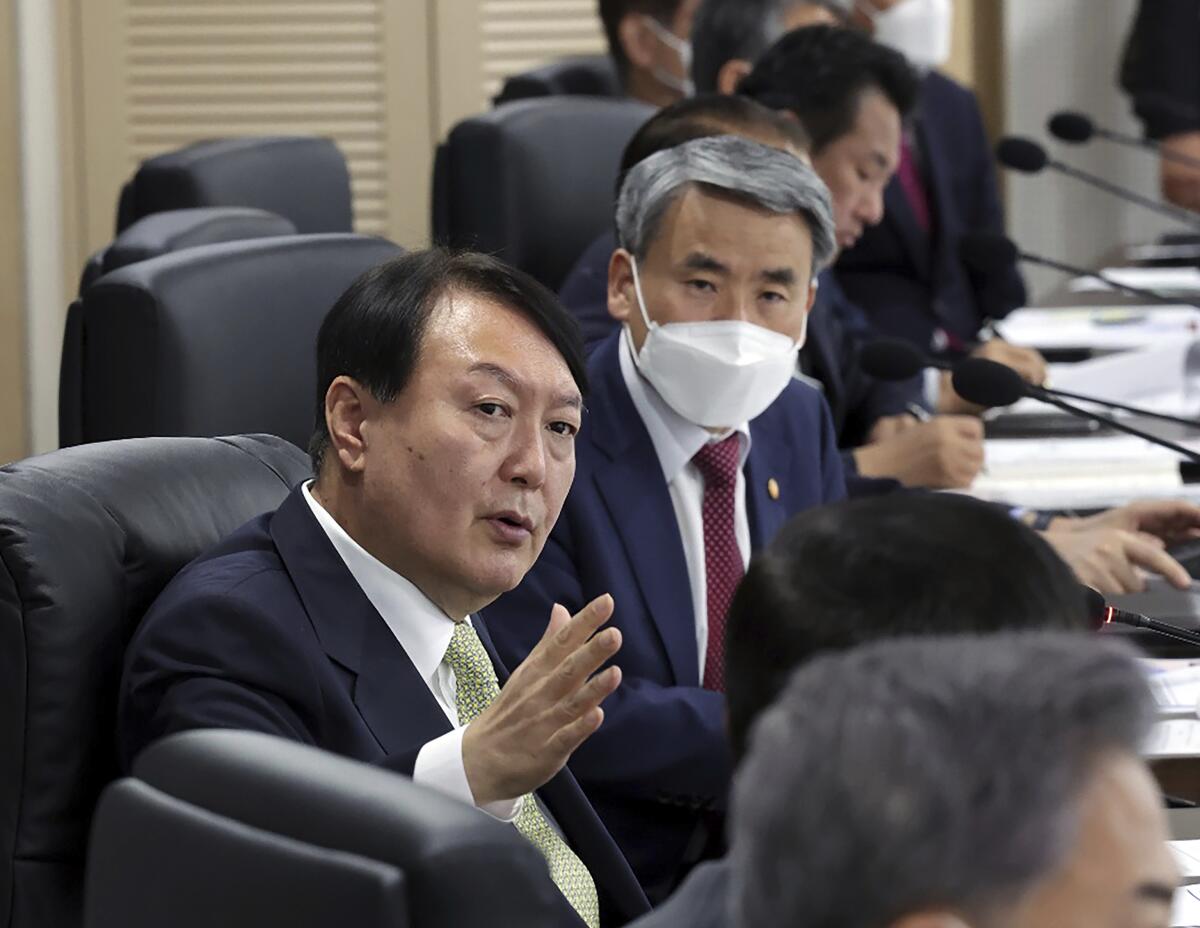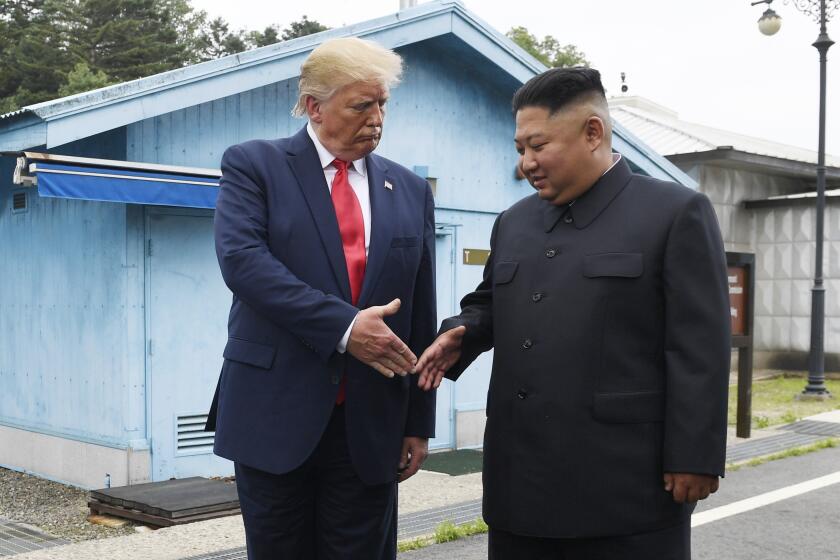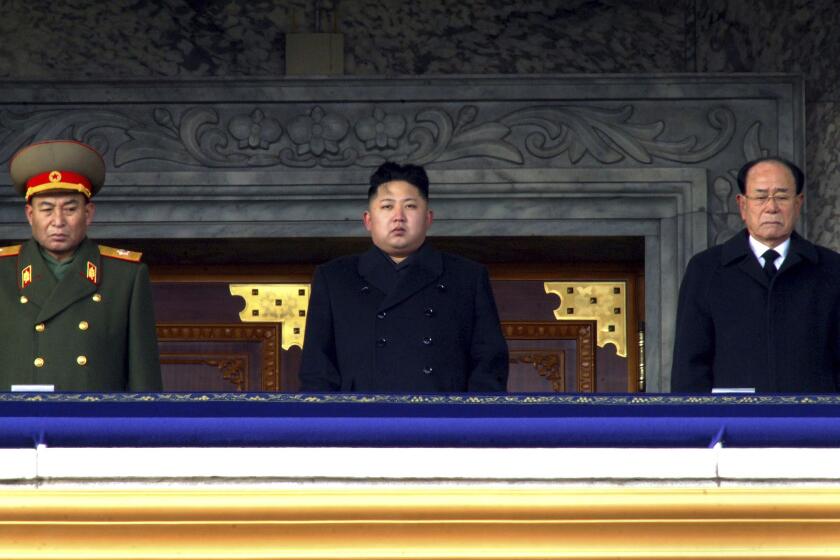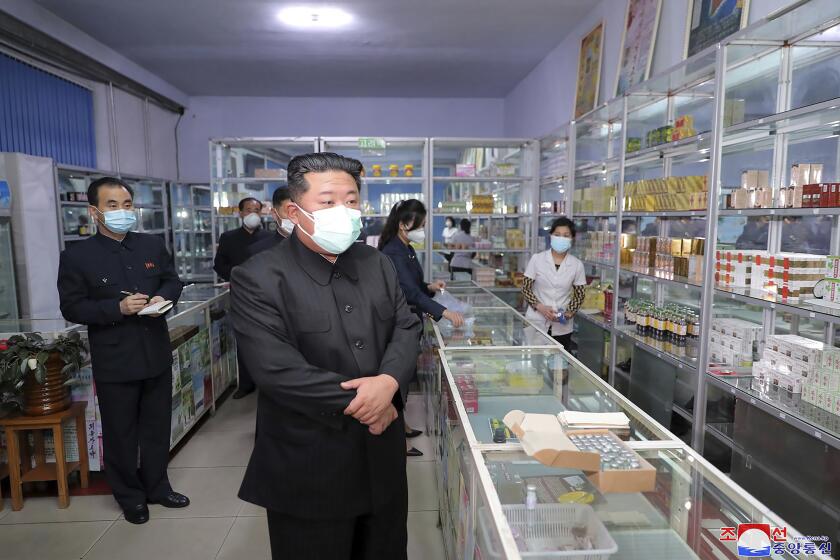North Korea fires suspected ICBM and 2 other missiles hours after Biden’s Asia trip

- Share via
SEOUL — North Korea test-launched a suspected intercontinental ballistic missile and two shorter-range weapons into the sea Wednesday, South Korea said, hours after President Biden ended a trip to Asia, where he reaffirmed the U.S. commitment to defend its allies in the face of Pyongyang’s nuclear threat.
If confirmed, it would be North Korea’s first ICBM launch in about two months amid stalled nuclear diplomacy with the U.S. The latest launches suggest that the North is determined to continue its efforts to modernize its arsenal despite its first COVID-19 outbreak, which has caused outside worries about a humanitarian disaster.
“North Korea’s sustained provocations can only result in stronger and faster South Korea-U.S. combined deterrence and can only deepen North Korea’s international isolation,” the South Korean government said in a statement after an emergency security meeting.
Japanese Defense Minister Nobuo Kishi called the launches “an act of provocation and absolutely impermissible.” The U.S. Indo-Pacific Command earlier said the missile launches highlight “the destabilizing impact of [North Korea’s] illicit weapons program,” though they didn’t pose an immediate threat to U.S. territory or allies.
According to South Korea’s military, the three missiles lifted off from the North’s capital region one after another Wednesday morning before they landed in waters between the Korean Peninsula and Japan.
A military statement said that the first missile was likely an ICBM and that it reached a maximum height of 335 miles while traveling 223 miles. The statement said the second missile disappeared from South Korean radar at some point, and the third missile flew 472 miles on an apogee of 37 miles.
Trump’s ‘fire and fury’ strategy didn’t work, but will Biden’s? Intelligence officials worry Kim is up to something, especially as Biden visits South Korea this week.
Kim Tae-hyo, South Korea’s deputy national security advisor, told reporters that the first missile was assessed as a Hwasong-17 missile — the North’s biggest, whose potential range includes the entirety of the U.S. mainland. He said the missile was fired at a high angle and that its launch appeared aimed at reviewing the weapon’s propellant and stage separations, though he couldn’t conclusively say whether the test was successful.
He said the tests of the two other missiles, both short-range weapons, showed North Korea’s intention to improve its ability to launch nuclear strikes on its rivals.
While the North Korean launches were part of its weapons-development program, they were also strategically timed to coincide with the end of Biden’s Asian tour and likely designed to test the readiness of South Korea’s new government, which took office about two weeks ago, Kim said.
The flight details for the suspected ICBM were similar to those of two previous North Korean launches, which the South Korean and U.S. militaries have said were meant to test components of the North’s Hwasong-17 missile — its biggest — in launches that flew medium distances, not the full range. North Korea said at the time that the two launches were meant to test cameras for a spy satellite.
North Korean leader Kim Jong Un reaches 10 years in power
After those two earlier launches, South Korea’s military in March detected what it said was a North Korean Hwasong-17 that blew up soon after liftoff. Later in March, North Korea claimed to have successfully launched the Hwasong-17 in its first full-range ICBM flight test that broke its self-imposed 2018 moratorium on long-distance launches.
South Korea said the North may have fired a smaller ICBM, not a Hwasong-17. Whichever it was, the missile flew longer and higher than any other weapon the North has ever tested and had the potential range to reach the entire U.S. mainland, experts say.
Lee Choon-geun, an honorary research fellow at South Korea’s Science and Technology Policy Institute, said it was possible the North tested Hwasong-17’s booster first stage and other technical elements to avoid another failure in a full-range test.
Chang Young-keun, a missile expert at Korea Aerospace University in South Korea, said the North’s two earlier launches prior to its exploded missile were likely aimed at testing clustered engines. Given that, he said he doubted whether North Korea truly launched an ICBM again Wednesday because the country would have no reason to conduct the same test repeatedly and waste an ICBM that costs about $8 million to $16 million.
Start your day right
Sign up for Essential California for the L.A. Times biggest news, features and recommendations in your inbox six days a week.
You may occasionally receive promotional content from the Los Angeles Times.
Chang said the flight details of the third missile resemble those of the hypersonic missile that North Korea tested in January. Other analysts say it could also be the North’s highly maneuverable, nuclear-capable KN-23 missile.
There’s less ambiguity about what Pyongyang was trying to show by mix-launching an ICBM and short-range missiles, Lee said. After Biden recently stressed the U.S. commitment to defend South Korea and Japan during his visits to those countries, North Korea responded by demonstrating its pursuit of an ability to conduct nuclear attacks on both the U.S. mainland and its allies in Asia, he said.
The launches “were a political message. They’re saying they feel bad” about Biden’s recent summit with South Korean President Yoon Suk-yeol, Chang said.
Biden and Yoon said after their meeting Saturday that they would consider expanded military exercises to deter North Korean nuclear threats.
North Korean leader blasts officials over slow medicine deliveries and orders military to help in the nation’s COVID-19 crisis.
Biden brushed aside questions about any possible provocation by the North during his trip, saying: “We are prepared for anything North Korea does.” Biden later met with Japanese Prime Minister Fumio Kishida in Tokyo, and they vowed to work closely to address security challenges, including North Korea’s nuclear and ballistic programs and what they called China’s “increasingly coercive” behavior in the region.
After the North’s launches, the South Korean and U.S. militaries said they fired two surface-to-surface missiles to demonstrate their striking capabilities. Seoul officials said the allies had detected North Korea’s preparations for the launches in advance. They said South Korea’s air force Tuesday conducted an “elephant walk” involving 30 fully armed F-15K fighter jets parading along a runway in formation.
Wednesday’s launches were North Korea’s 17th round of missile firings this year. Experts have said North Korea wants to move ahead with its push to modernize its weapons arsenals and apply more pressure on its rivals to wrest sanctions relief and other concessions amid dormant nuclear diplomacy.
U.S., South Korean and Japanese officials have said North Korea could soon conduct its first nuclear test in nearly five years as well. Kim, the South Korean deputy national security advisor, told reporters Wednesday that North Korea has been testing a trigger system for a nuclear explosive device and other technologies.
More to Read
Sign up for Essential California
The most important California stories and recommendations in your inbox every morning.
You may occasionally receive promotional content from the Los Angeles Times.












